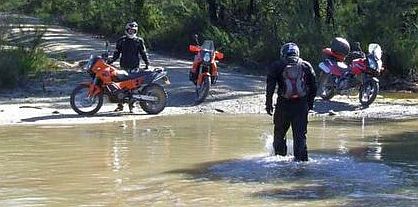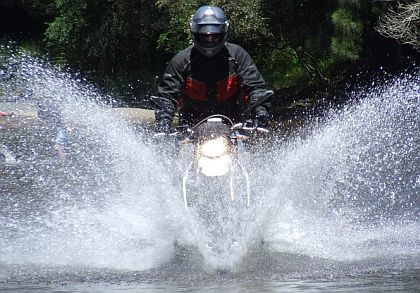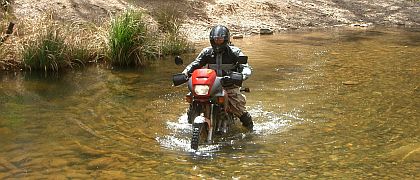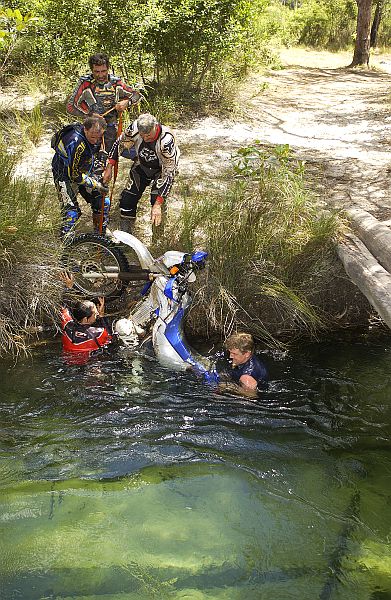Creek Crossings
It’s all too easy to get swept away
If you want to spot the experienced rider in a group, watch the various approaches to water crossings. There’ll be the rider who wheelies in, the member of the Light Brigade who tries the late charge, the submariner who inevitably finds the deepest spot, and the cautious soul who stops, looks, and maybe even walks the crossing before proceeding. The last one is your man. He’s cautious all right, amongst a group renowned for taking risks, but he’s cautious for a reason. He knows that it takes 15-30 minutes to de-water a bike, and that’s if you know what you’re doing. He also knows that oil and water do not mix, especially in sumps where it is vital for lubrication and in the creek where it pollutes, and that falling over in a river inevitably leads to getting wet. You want to spot the experienced rider? He’s the first one to walk his bike through a creek crossing. You’ll never see him spin the rear because he knows this is the quickest way to go over and it muddies or pollutes the water and damages fragile bed or bank of the creek.
Look First
Some crossings can be evaluated at a glance. Smooth, sandy entry, shallow bottom, smooth exit; you hardly pause before riding through. Others aren’t so straight-forward, and are worthy of a little respect. Water can hide multiple evils. Look for submerged logs that will be horribly slippery, check if the rocks are green with slime, because they’ll be like riding on ice, and take extreme care on concrete causeways because they can be slipperier than a merchant banker at a Senate enquiry. Gauging depth is difficult because water refracts light, bends it, so it always looks shallower than it is.

All of this information can be assessed from the saddle if the water is clear, which it often is if you’re the lead rider. Those further back in the group should wait a few seconds for any sediment to wash clear before chancing their luck. If the water is murky, walk it. Feel with your boots for rocks and logs, and while you’re wet you may as well see if there’s a better line. Look for a path that allows you to enter the crossing at a brisk walking place, and for an exit that is neither steep not greasy. If the bottom has boulders, look for alternative exits because there is a reasonable chance of spearing off a rock at an unexpected angle. You may need to position riders at the exit to lift each bike out, or even build up the exit with boulders to avoid falls and damage to the creek bank.
Still water is usually deep, but will often have a smoother bottom. Rapids will be shallower but only the bigger rocks survive there, so the path may not be clear. Usually the best line is just upstream from any broken water.

Most crossings have compacted lines formed by 4WD use. These have the least slime and are often the smoothest path. Avoid soft sandbanks or places where sediment has built up, because these are literally sand traps that will bog bike. And beware of deep mud on the banks. You need a firm bottom that will give drive.
Walk or Ride
If you are confident that the crossing presents no problems, then ride it, but if there are any doubts at all the smartest thing is to walk the bike through. Put the bike in first gear, stand on the downstream side so you can brace against the current, and work the bike across with a light hand on both the throttle and the clutch. Don’t take a step until you’re sure of your footing, and if the bike jams against a rock do not try to get over it by spinning the rear wheel – all this will do is splash water into the airbox intake, bog the rear, and churn up sediment in the water. Getting a mate to roll the front wheel will move a bike much more easily and with less chance of a drowning.
Riding a creek crossing takes confidence. Select first, and approach the water at the aforementioned brisk walking pace, standing on the pegs. If you go faster the front wheel will wobble and fight in the current, while water sprays your goggles and blinds you. Too slow and momentum is lost and you end up paddling across with legs flailing. If this happens, it’s better to walk the bike than to continue with poor balance. Still upright? Work the throttle and clutch. The idea is to keep drive so you don’t want the back to spin; you need to bounce over things, hold a reasonably straight line, and keep the bike upright.

Again, if the bike gets stuck midstream dismount, call for a mate to roll the front wheel and walk it the rest of the way. If you’re on your own, it may be possible to tip the bike on your knee or its side stand, and pivot it over the obstacle. Don’t panic. Take your time and think things through, and don’t ever sit there and spin, this simply pollutes the water with soil and sediment.
Seriously Deep
If the water is high enough to enter the airbox then think seriously about finding another crossing or turning back. If these aren’t options, remove the airfilter, put it in a plastic bag and place it back in position in the airbox. Kink the carb breathers or plug them with sticks, and use a second plastic bag to block the muffler hole – rubber bands from old tubes work well here. Get two or three mates, and push the bike through, unblock everything, and it should run. Don’t forget to block the tank breather if things are silly.
Alternatively, a truck tube will float a bike, and four or five blokes can carry a bike at shoulder height by placing sticks through the wheels and lifting from there.
Hydraulic Lock
If your bike takes a swim, remember that unlike air, water does not compress. If the piston attempts to reach top dead centre when the combustion chamber is full of water, it will bend a rod. Never try to kick or electric start a bike that has been under water. Drag it out of the drink to a dry spot on the bank, and before doing anything else check to see if your sump oil is milky. If the oil is milky or its level raised, you have water in the sump and you have to remove it. Carefully back the sump plug off until the water, which will be on the bottom, starts to trickle out. Allow this to continue until you get the first few drops of oil (being careful to not make a mess of the environment you are in), then retighten the plug. By doing this early, you avoid mixing the oil with the water, which gives a better chance of getting the bike out without suffering damage. Even so, change the oil as soon as you can, even if this means using non-bike oils.

Make sure you properly dispose of the used oil. Carry it out with you, just as you carry fresh oil in. Do not just drain it onto the ground, that does severe environmental damage.
To dewater a bike, follow the path of the water. Start at the airbox. Drain it of water, remove the filter and either put it in the sun to dry or give it to another rider to dry behind his muffler. Drain the carb bowl, remove the sparkplug then remove the header pipe and drain the exhaust as well. Stand the bike on its rear then turn the motor over and let the water spray out of the sparkplug hole. Now put the whole lot back together and see if it starts. Often a bike will idle but not rev. This is a sure sign that there’s a glob of water blocking the main jet and you then have no choice but to remove the main and blow it out, which can mean stripping some carbs.
Legends
The difference between a legend and a loser is usually about half a second. The rider who puts on a show at a creek crossing is all too often the one who puts an extra hour on the time it takes to reach the pub or the bike trailer that night, and is also the one most likely to have fish fingers for dinner, no matter what he orders. Evaluate each crossing, if in doubt walk, and if things get untidy do not rely on your throttle to get you out. Use your brain instead. Creek crossings are generally pretty spots but are particularly prone to erosion damage. Treat them with care, and those who follow you will have an equally enjoyable crossing.
Please Note
It’s a sad truth that most water in the NSW rivers and streams is unfit to drink. Giardia and the like are rife and will cause diarrhoea and vomiting for two to three days. Some is fine, especially for locals who develop immunity, but why take the chance? Carry your water in, filter it, or use Puratabs to sterilize the water before drinking.
